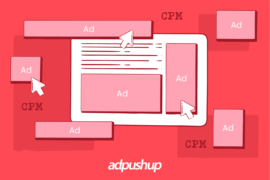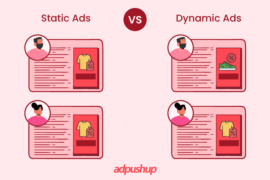Retargeting is not new to anyone—since it’s been around for a while. Advertisers and marketers (especially from e-commerce) use retargeting ads to sell products and increase conversion rates.
In this post, we will discuss the publisher side of the story and answer some common questions, including—how do retargeting ads work on their websites/apps? Do they benefit publishers as much as they do advertisers?
What Does Retargeting Mean?
Retargeting means re-engaging with users by showing them ads of products or services they previously checked on a website. The intent is to create recall value by showing relevant ads and turn website visitors into customers. Typically, these ads follow users throughout the web, compelling them to take the purchase action.
Advertisers use cookies to know more about their users. To show relevant ads, they require publisher-side data to identify users for retargeting.
Retargeting can be divided into two types:
- In search retargeting, ads are served based on the search history of the user. For instance, if a user searches for sports shoes on a search engine, they might soon see ads of sports shoes on the search engine.
- In site retargeting, ads are served to the user on different websites using cookies. For example, if a user checks out a bag on a website, the same bag will start appearing on sites that the user visits afterward.
Pros and Cons of Retargeting
Pros:
- For publishers: Retargeted ads usually get better click-through rates (CTR). Users also tend to notice retargeted ads more than any other ad, which helps publishers fight banner blindness. Combined, this helps publishers get better inventory rating in the marketplace while improving their ad revenue.
- For advertisers: Retargeting saves advertisers from the trouble of finding interested users. Based on the previous engagement of users with the products on the website, advertisers can easily show them ads of the same or related products to evoke their interest.
- For users: Seeing a familiar product increases the chance of a user clicking on it and purchasing the product. Retargeting helps users by reminding them about their interaction with a product, website, or service, encouraging them to complete their purchase action.
Cons:
- For publishers: Seeing the same ads prompts users to download ad blockers, thereby negatively affecting the ad revenue of the publisher. The problem can be solved by putting better frequency caps in place.
- For advertisers: Sometimes when users get annoyed by seeing the advertiser’s product and ad repetitively, it affects the value and reputation of the brand.
- For users: Some users might find it annoying to see the same ads over and over again. If not executed well, it’s also likely that these ads can appear to users who have already purchased the product.
The Publisher Side Story
There is no doubt that retargeted ads generate better CTR. According to data shared by Connectio.io, 3 out of 4 users notice retargeted ad and they are 76% more likely to be clicked compared to regular display ads.
However, just like other ads, the earnings depend on traffic quality. A low CPM can be an indication of low-quality traffic. On the publisher side, there is always plenty of optimization to be made when it comes to ad revenue.
Should publishers run retargeting ads on their website? Simple answer—go for it, but don’t stop just there. Monitor the performance of the website in terms of UX and revenue. Keep testing and optimizing ad performance.
Tips to Make the Most Out of Retargeting
It may seem that retargeting is more of an advertiser-side activity. However, publishers can also profit from it. Here’s what they can do:
- Show relevant ads: A site displaying relevant ads brings out more confidence in users to click on them. Not just in case of retargeting, but also with other ads placed on the site, publishers are recommended to enable niche targeting. Such ads draw user attention and help publishers get more ad revenues.
- Improve cookie syncing: Retargeting works because of the cookie syncing. Meaning, the sharing the cookie data of users between publishers and advertisers, then using this data to identify the users. Hence, publishers should focus on improving the cookie syncing process to help advertisers better target users.
Lastly, publishers should understand that wrong ad placements can lead to a drastic drop in the ad revenue and UX-related metrics. Moreover, bad ad experience makes users install ad blockers, further putting publisher profits in jeopardy. In order to see the benefits of retargeting, publishers need to keep up with best practices for maintaining optimal ad experience.

Shubham is a digital marketer with rich experience working in the advertisement technology industry. He has vast experience in the programmatic industry, driving business strategy and scaling functions including but not limited to growth and marketing, Operations, process optimization, and Sales.







